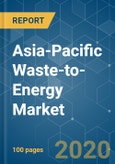Asia-Pacific waste-to-energy market is expected to grow at a CAGR of greater than 2.5% during the forecast period. With the increasing rate of municipal waste generation, the countries around the region are giving emphasis on reducing the waste by utilizing it to generate energy in the form of methane. Using the municipal waste to generate substantial energy in the form of heat and electricity can help to stabilize the increasing carbon footprint, that are getting generated by burning various fossil fuels such as coal and natural gas to produce energy. Organic waste, a form of municipal waste, is the largest form of waste that is mostly getting generated from the developing nations in the region, accounts nearly 53% of the total waste generates annually in the region. Waste to Energy (WtE) implies a set of technologies that treat municipal waste to extract energy in the form of heat and electricity. Uses of the technologies also help to obtain biogas as an alternate form of fuel. The drivers of the market are the increasing dumping and open burning of wastes that directly or indirectly impact human health and the environment. However, WtE plants produce ash that needs to be disposed of safely, usually in landfills that are lined with barriers to prevent ground water contamination.
Key Market Trends
Incineration as a Prominent Technology
China has a Significant Market
Competitive Landscape
The Asia-Pacific waste-to-energy market is fragmented. The key owners in the market include Wood Group Plc, Babcock & Wilcox Enterprises Inc., C&G Environmental Protection Holdings Ltd., Everbright International Ltd., Covanta Holding Corporation, Green Conversion Systems, Inc., and Hitachi Zosen Corporation, amongst others.
Reasons to Purchase this report:
This product will be delivered within 2 business days.
- Incineration is one of the prominent waste to energy technology. During the year 2018, the technology nearly covered almost 40% of the total waste to energy installations in the region.
- Waste generation is overgrowing in the region with the increasing population. By 2050, Asia-Pacific is expected to have around 1.3 billion tonnes of waste. Moreover, daily per capita waste generation in the region is expected to get increase by nearly 40% by 2050. Thus, increasing municipal waste volume and increasing demand for energy in the region is expected to create an opportunity for the waste-to-energy market in the near future.
- China is one of the prominent countries in the WtE market, with Shanghai as the major city that process the highest waste to generate energy for heat and electricity purpose. The country produces an annual amount of over 220 million tons of municipal waste per year.
Key Market Trends
Incineration as a Prominent Technology
- For an incineration process, waste materials are burned inside a specific chamber by raising the temperature to around 850-1450 degrees Celsius, adding oxygen to have a combustion reaction. A minimum calorific value of the waste is required for self-combustion of the trash.
- During the process, exhaust gases called flue gases are created, which is cleaned up before exiting from the facility. This flue gas contains the heat energy that is utilized to generate electricity or for heating purposes.
- The operation of incineration is more complex than the operation of a sanitary landfill. It requires well developed technical and management skills to set and adjust the parameter for the effective operation of the plant.
- During 2018, there are more than 1500 incineration plants in the Asia-Pacific region. China is one of the prominent country, that has installed the world’s largest incineration plant (The Shenzhen East waste-to-energy plant) in 2019. The plant has a capacity of processing 2.7 million tonnes of waste per year and is capable of generating 1.5 billion kilowatt-hours of power per year.
China has a Significant Market
- China is the second-largest producer of municipal waste in the world that initiated waste sorting plans during 2017 and aims to recycle 35% of waste in 46 major cities, including Shanghai, by 2020.
- In China, the number of incineration plants has increased from 74 in 2008 to around 400 in 2018. Beijing is planning to double its incineration capacity, and to burn 54% of the municipal wastes by 2020. Under Chinese President Xi Jinping’s plan to tackle pollution, the incineration industry is expected to continue its expansion, in order to replace stinky, polluting, land-intensive garbage dumps. Moreover, with its burgeoning economy producing vast quantities of garbage (increasing 8-10% annually), China is turning to new facilities that burn solid waste to produce electricity.
- As per International Energy Agency (IEA), China has around 7.3 gigawatts of installed waste to energy capacity, with its 339 plants during 2017. The country’s waste to energy has grown by 1 GW per year on average from last five years and is expected to continue the growth with rising municipal waste.
Competitive Landscape
The Asia-Pacific waste-to-energy market is fragmented. The key owners in the market include Wood Group Plc, Babcock & Wilcox Enterprises Inc., C&G Environmental Protection Holdings Ltd., Everbright International Ltd., Covanta Holding Corporation, Green Conversion Systems, Inc., and Hitachi Zosen Corporation, amongst others.
Reasons to Purchase this report:
- The market estimate (ME) sheet in Excel format.
- Report customization as per the client's requirements.
- 3 months of analyst support.
This product will be delivered within 2 business days.
Table of Contents
1 INTRODUCTION
4 MARKET OVERVIEW
5 MARKET SEGMENTATION
6 COMPETITIVE LANDSCAPE
Companies Mentioned (Partial List)
A selection of companies mentioned in this report includes, but is not limited to:
- Wood Group Plc
- Babcock & Wilcox Enterprises Inc
- C&G Environmental Protection Holdings Ltd
- Everbright International Ltd.
- Covanta Holding Corporation
- Plantec Asia Pacific Pte Ltd.
- Hitachi Zosen Corporation
- Keppel Seghers
- Suez Environnement Company
- Mitsubishi Heavy Industries, Ltd.
Methodology

LOADING...








